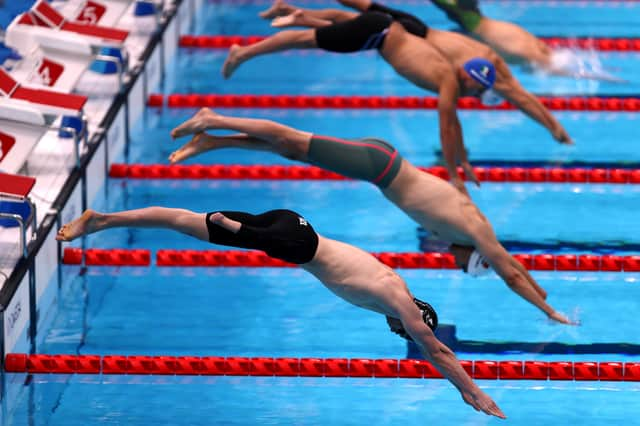Paralympics 2021 swimming classification: S5, S8, S11, S12, S14 and more categories explained at Tokyo 2020


The delayed Tokyo 2020 Paralympic Games are underway.
The Paralympics might only have just begun but there has been plenty of medal action taking place, particularly in the pool.
Para swimming is a big part of the Paralympics schedule with no fewer than nine days of competition at the Games held in Japan.
Advertisement
Hide AdAdvertisement
Hide AdGB athletes have already made a splash with Reece Dunn and Tully Kearney taking silver in the men’s 100m butterfly and women’s 200m freestyle respectively.
The Tokyo Aquatics Centre will be one of the busiest venues through the 2021 Paralympics with heats and finals on every day from 25 August to 3 September.
Here’s all you need to know about swimming classifications at the Games.
Why are there different swimming classifications at the Paralympics?
Athletes at the Tokyo 2020 Paralympic Games have a variety of impairments.
Advertisement
Hide AdAdvertisement
Hide AdIn order to maintain a fair competition for athletes, a system is in place to assess the impact an impairment has on swimming performance rather than the impairment itself.
"To ensure competition is fair and equal, all Paralympic sports have a system in place which ensures that winning is determined by skill, fitness, power, endurance, tactical ability and mental focus, the same factors that account for success in sport for able-bodied athletes," states World Para Swimming.
Para swimming is split into three impairment categories - physical, intellectual and vision - with the classification process breaking those groups down even further.
What do the letters S, SB and SM mean in para swimming?
Each para swimming classification has a unique code to identify which race is taking place.
Advertisement
Hide AdAdvertisement
Hide AdThe codes begin with either the letter ‘S’, ‘SB’ or ‘SM’ which is used to identify the stroke. ‘S’ shows the stroke is a freestyle, butterfly or backstroke event, ‘SB’ is breaststroke and ‘SM’ is individual medley.
The number which follows the letter stands for the classification.
Para swimming classifications - physical impairment
The classifications S1-S10, SB1-SB9, and SM1-SM10 are used to show the event is for athletes with a physical impairment.
The lower the number that follows the letter(s) the more severe the activity limitation.
- S1/SB1 - Swimmers in this sport class have a significant loss of muscle power or control in legs, arms and hands. Some athletes also have limited trunk control. This may be caused by tetraplegia, for example. Swimmers in this class usually use a wheelchair in daily life.
- S2/SB1 - Swimmers in this sport class mainly rely on their arms for swimming. Their hand, trunk and leg function is limited due to tretraplegia or co-ordination problems, for example.
- S3/SB2 - This sport class includes athletes with amputations of both arms and legs. Swimmers with reasonable arm strokes but no use of their legs or trunk and swimmers with severe co- ordination problems in all limbs are also included in this sport class.
- S4/SB3 - Swimmers who can use their arms and have fair function in their hands, but who cannot use their trunk or legs would swim in this sport class. Athletes with amputations of three limbs could also swim in this sport class.
- S5/SB4 - Swimmers with short stature and an additional impairment, with loss of control over one side of their body (hemiplegia) or with paraplegia compete in this sport class.
- S6/SB5 - This sport class includes swimmers with short stature or amputations of both arms, or moderate co-ordination problems on one side of their body, for example.
- S7/SB6 - This sport class is designated to athletes with one leg and one arm amputation on opposite sides, or a paralysis of one arm and one leg on the same side. Moreover, swimmers with full control over arms and trunk and some leg function can compete in this class.
- S8/SB7 - Swimmers who have an amputation of one arm are eligible to compete in this sport class. Also, athletes with significant restrictions across hip, knee and ankle joints could compete in this sport class.
- S9/SB8 - Athletes in this sport class, for example, swim with joint restrictions in one leg or with double below-the-knee amputations.
- S10/SB9 - This class describes minimal physical impairments of eligible swimmers. These include the loss of one hand or a movement restriction in one hip joint.
Para swimming classifications - visual impairment
Advertisement
Hide AdAdvertisement
Hide AdThe classifications S/SB11-13 are used to show the event is for athletes with a visual impairment.
- S/SB11 - These athletes have a very low visual acuity and/ or no light perception.
- S/SB12 - Athletes have a higher visual acuity than athletes competing in the S/SB11 sport class and/ or a visual field of less than 5 degrees radius.
- S/SB13 - Athletes have the least severe vision impairment eligible for Paralympic sport. They have the highest visual acuity and/or a visual field of less than 20 degrees radius.
In order to ensure a fair competition athletes in the S/SB11 sport class are required to wear blackened goggles. To ensure safety all S/SB11 swimmers must use a tapper, swimmers in the S/SB12 and S/SB13 sport classes may choose whether or not they wish to use one.
Para swimming classifications - intellectual impairment
The classifications S/SB14 are used to show the event is for athletes with an intellectual impairment.
- S14 - swimmers have an intellectual impairment, which typically leads to the athletes having difficulties with regards to pattern recognition, sequencing, and memory, or having a slower reaction time, which impact on sport performance in general. Moreover, S14 swimmers show a higher number of strokes relative to their speed than able-bodied elite swimmers.
Comment Guidelines
National World encourages reader discussion on our stories. User feedback, insights and back-and-forth exchanges add a rich layer of context to reporting. Please review our Community Guidelines before commenting.
